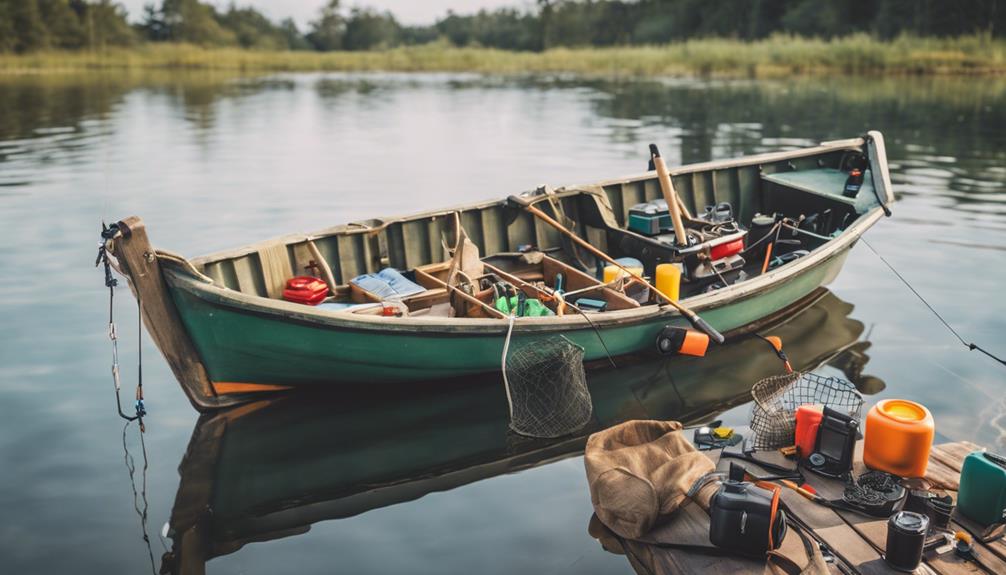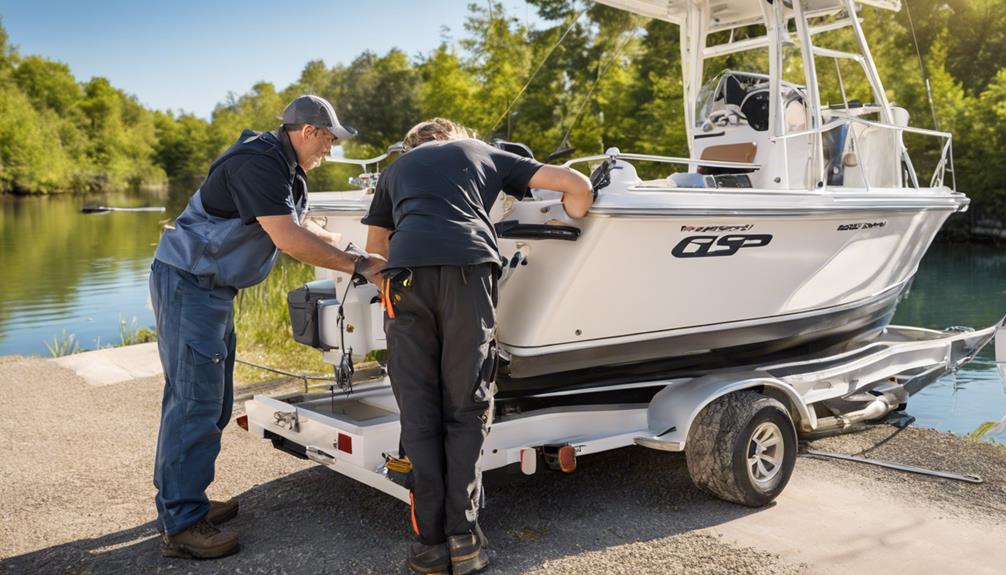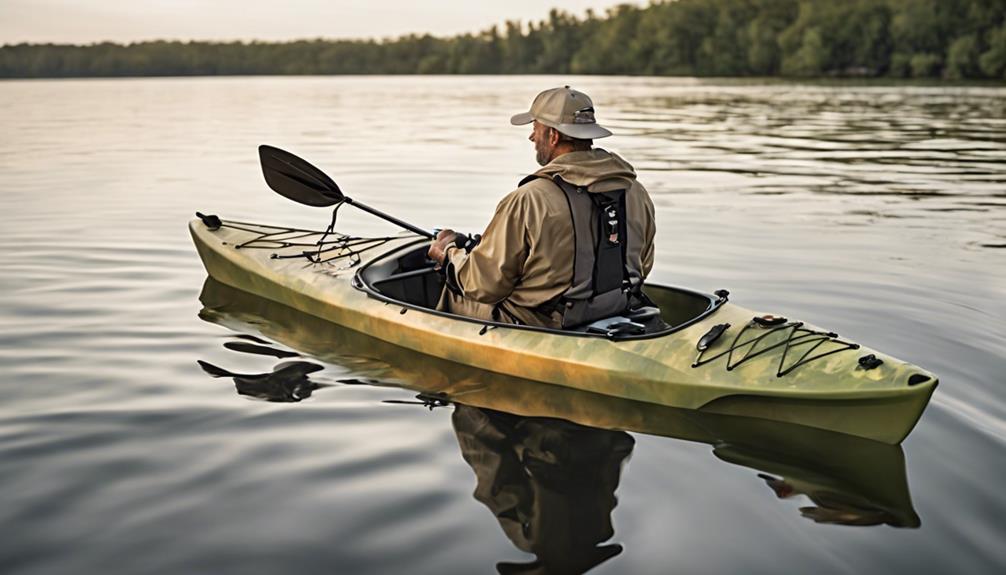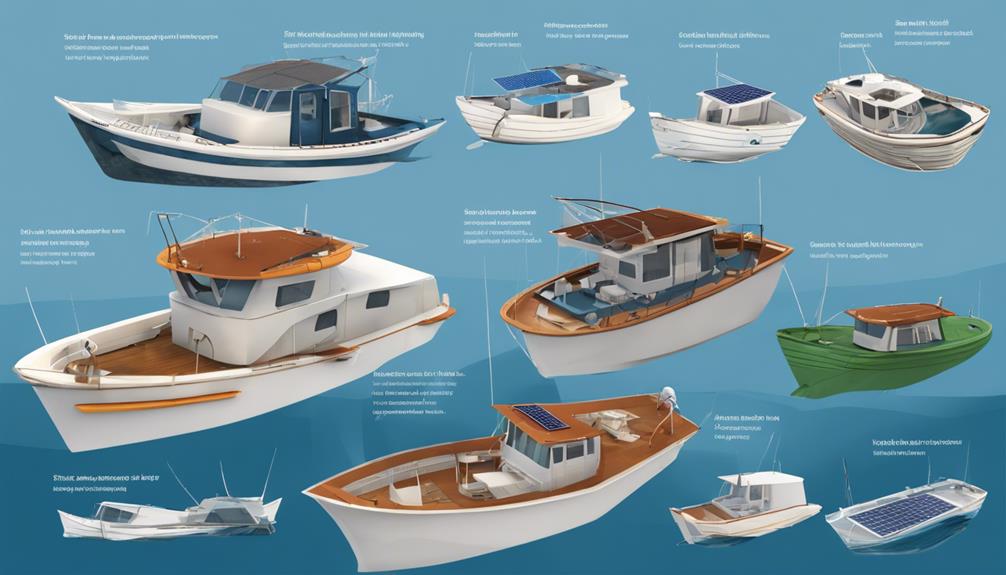You've decided to explore the world of fishing, and now you're considering getting a boat. But where do you start? Understanding the basics of fishing boats is crucial for beginners.
From the various types of boats available to the essential accessories you might need, navigating this new territory can seem overwhelming. However, with a solid foundation on the basics, you'll be better equipped to make informed decisions and set sail confidently on your fishing adventures.
Types of Fishing Boats
When choosing a fishing boat, consider the various types available to suit your needs and preferences. Boat design plays a critical role in how well you can execute different fishing techniques. Understanding the different types of fishing boats can help you make an informed decision based on your fishing style and preferences.
One common type of fishing boat is the bass boat, known for its low profile and ability to navigate shallow waters where bass often hide. Bass boats are designed for casting and retrieving techniques, making them ideal for bass fishing enthusiasts. On the other hand, center console boats are versatile vessels suitable for various fishing techniques, including trolling, bottom fishing, and offshore angling. Their open deck design provides ample space for maneuvering and storing fishing gear.
If you prefer offshore fishing, consider a sportfishing boat designed for deep-sea expeditions. These boats typically feature a sturdy hull, powerful engines, and advanced navigation systems to handle rough waters and long journeys. For anglers who enjoy fly fishing in shallow waters, a flats boat is a popular choice due to its shallow draft and poling platform, allowing for precise maneuvering in skinny waters.
Ultimately, the best fishing boat for you'll depend on your preferred fishing techniques and where you plan to fish. Take the time to research and test different types of fishing boats to find the perfect match for your angling adventures.
Fishing Boat Materials
Exploring the construction materials used in fishing boats can offer valuable insights into their durability and performance on the water. Boat construction plays a crucial role in the overall strength and longevity of a fishing vessel. When it comes to material selection, fiberglass is a popular choice due to its durability and resistance to corrosion. Fiberglass boats are low maintenance and can withstand the harsh marine environment well. Aluminum is another commonly used material known for its lightweight properties and resistance to rust. Aluminum boats are easy to maneuver and offer good fuel efficiency, making them a preferred choice for many anglers.
Wood was traditionally used in boat construction, but it requires more maintenance to prevent rot and deterioration. Despite the classic appeal of wooden boats, modern anglers often opt for more low-maintenance materials. However, newer technologies have allowed for the development of composite materials that combine the best characteristics of different materials. These composites offer a good balance between durability and weight, making them a versatile choice for fishing boats.
In terms of maintenance, regardless of the material used, regular cleaning and proper storage can significantly extend the lifespan of a fishing boat. Ensuring that the boat is well-protected from the elements and properly maintained will help preserve its structural integrity and performance on the water.
Storage Options on Boats
What're the storage options available on fishing boats to help keep your gear organized and accessible while out on the water? When heading out for a day of fishing, having a well-organized storage system can make your experience more enjoyable and efficient. Here are some essential storage options commonly found on fishing boats:
- Tackle Trays: Tackle organization is crucial for any angler. Having tackle trays or boxes with compartments helps keep your lures, hooks, weights, and other tackle items neatly arranged and easy to access.
- Rod Holders: Rod holders are convenient for keeping your fishing rods secure while you're busy with other tasks. They help prevent tangles and keep your rods safe during transit.
- Storage Compartments: Many fishing boats come equipped with various storage compartments located throughout the vessel. These compartments are ideal for storing extra gear, personal belongings, and supplies you want to keep dry and secure.
- Live Bait Wells: Live bait wells are essential for anglers using live bait. These compartments keep your baitfish alive and healthy, increasing their attractiveness to target fish.
- Coolers: Having a cooler on board is essential for storing drinks, snacks, and any fish you plan to keep. Some coolers are designed to double as seats, providing additional seating options on the boat.
Having these storage options on your fishing boat will help you stay organized, prepared, and focused on enjoying your time on the water.
Understanding Boat Motors
To fully enjoy your fishing experience, understanding boat motors is essential for efficiently navigating the waters and reaching your desired fishing spots. When it comes to boat motors, two crucial aspects to consider are motor maintenance and engine power.
Motor maintenance is key to ensuring your boat motor operates smoothly and reliably. Regularly check and change the oil, inspect the propeller for any damage, and keep the motor clean from debris that could affect its performance. It's also important to follow the manufacturer's maintenance schedule to prevent any unexpected breakdowns while out on the water.
Engine power is another vital factor to understand. The power of a boat motor is typically measured in horsepower (HP), with higher HP engines providing more speed and better performance, especially in rough waters. Consider the size and weight of your fishing boat when selecting the appropriate engine power to ensure it can propel the vessel efficiently.
Essential Fishing Boat Accessories
Consider equipping your fishing boat with essential accessories to enhance your overall fishing experience. Here are five must-have items for your fishing boat:
- Fishing Rod Holders:
Fishing rod holders are crucial for keeping your rods secure and organized while you focus on navigating the waters and catching fish.
- Navigation Tools:
Navigation tools such as GPS systems or fish finders are essential for helping you locate the best fishing spots and safely navigate back to shore.
- Seat Cushions:
Comfort is key during long hours on the water. Investing in quality seat cushions will ensure you can fish for extended periods without discomfort.
- Tackle Storage:
Keep your fishing gear organized and easily accessible with tackle storage solutions. This will help you quickly switch baits or lures to adapt to changing fishing conditions.
- Cooler:
A cooler is essential for storing drinks, snacks, and any fish you catch. Look for a durable, insulated cooler to keep your refreshments cold throughout the day.
These accessories won't only make your fishing trips more enjoyable but also improve your overall efficiency on the water. Make sure to outfit your fishing boat with these essentials to maximize your time spent fishing.
Fishing Boat Safety Tips
Prioritize safety above all else when out on the water in your fishing boat. Familiarize yourself with emergency procedures before setting sail. Knowing how to handle emergencies like engine failure, taking on water, or medical issues can make a crucial difference in keeping you and your passengers safe. Always have a well-stocked first aid kit on board and know how to use it in case of injuries.
Ensure that you have enough properly fitting life jackets for everyone on board. Life jackets are vital in case of an accident or if someone falls overboard. Make sure they're easily accessible and that everyone knows where they're stored. It's not just about having them; it's about wearing them. Encourage everyone to wear their life jackets at all times while on the water. In an emergency, there may not be enough time to put them on.
Regularly check your boat's safety equipment, such as fire extinguishers, distress signals, and navigation lights, to ensure they're in good working condition. Practice safety drills with your passengers so that everyone knows what to do in case of an emergency. Being prepared and prioritizing safety will help you have a more enjoyable and worry-free fishing experience.
Choosing the Right Boat Size
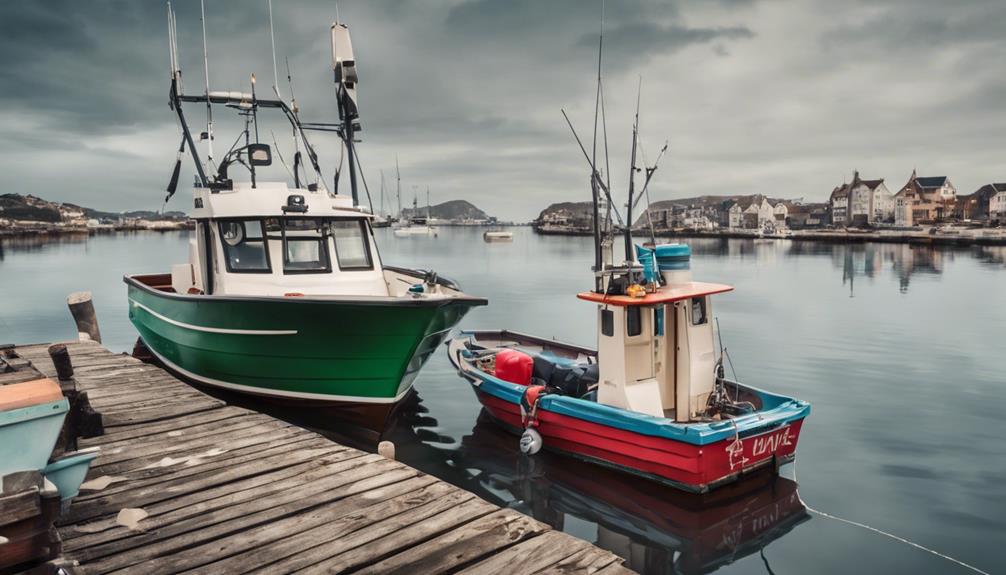
Selecting the appropriate boat size for your fishing needs is crucial for a successful and enjoyable experience on the water. When choosing the right boat size, consider factors such as boat stability and weight capacity.
- Boat stability: The size of your boat plays a significant role in its stability on the water. A larger boat tends to offer better stability, especially in rough waters, providing a more secure platform for fishing activities.
- Weight capacity: Understanding the weight capacity of a boat is essential to ensure you can safely carry yourself, your gear, and any catch without exceeding the boat's limits. Overloading a boat can compromise its stability and pose safety risks.
- Maneuverability: Smaller boats are generally more maneuverable, allowing you to navigate through tight spaces or shallow waters with ease. Consider where you plan to fish and whether a larger boat may limit access to certain fishing spots.
- Storage space: Larger boats often provide more storage space for fishing equipment, coolers, and other essentials. Evaluate your storage needs to determine the right boat size for keeping your gear organized and easily accessible.
- Transportation: Consider how you'll transport your boat to and from the water. Smaller boats are easier to tow, launch, and retrieve, while larger boats may require special equipment or services for transportation.
Maintaining Your Fishing Boat
To ensure your fishing boat remains in top condition and ready for your next angling adventure, regular maintenance is essential. Boat cleaning tips play a crucial role in keeping your vessel looking its best. Regularly wash the exterior with a mild detergent and water to remove salt, dirt, and grime. For stubborn stains, consider using specialized boat cleaners that won't harm the paint or finish. Additionally, don't forget to clean the interior to maintain a tidy and pleasant fishing environment.
When it comes to boat painting techniques, touch up any scratches or chips in the paint to prevent rust from developing. Choose marine-grade paint for durability and follow proper application procedures. Preventing rust is vital for the longevity of your fishing boat. Inspect metal parts regularly for signs of corrosion and address any issues promptly. Applying a marine-grade anti-corrosion coating can provide extra protection against rust.
Hull maintenance is another critical aspect of keeping your fishing boat in top shape. Inspect the hull regularly for any damage, such as cracks or blisters, and repair them promptly to prevent further deterioration. Keep the hull clean by regularly scrubbing off any algae or barnacles that can affect your boat's performance. By following these maintenance tips, you can ensure that your fishing boat stays in excellent condition for years to come.
Frequently Asked Questions
What Are Some Common Fishing Techniques Used on Fishing Boats?
When fishing on boats, common techniques like trolling and casting are often used. Trolling involves dragging bait or lures behind a moving boat to attract fish, while casting entails aiming and throwing your line towards specific spots.
Fly fishing utilizes lightweight lures to mimic insects, enticing fish to bite. Bottom fishing involves dropping baited hooks to the seabed to catch bottom-dwelling species. These techniques can vary depending on the type of fish you're targeting.
How Do You Properly Clean and Maintain Fishing Equipment on a Boat?
To keep your fishing gear shipshape on a boat, start by cleaning your equipment after each use. Rinse rods and reels with fresh water to remove salt and grime.
Proper storage is key; store gear in a dry, well-ventilated area to prevent rust and damage.
Regular maintenance is crucial; check for wear and tear, lubricate moving parts, and replace worn-out components.
Following these best practices will ensure your equipment stays in top condition for your next fishing adventure.
Are There Any Specific Regulations or Permits Required for Fishing on a Boat?
To fish on a boat, you must follow boat safety regulations and have the necessary fishing permits or licenses. Different areas may have specific requirements, so it's essential to check local regulations.
Make sure you comply with all rules to avoid any legal issues while enjoying your fishing experience. Remember, safety first and proper permits are crucial for a smooth and enjoyable fishing trip on your boat.
What Are Some Tips for Navigating and Reading Nautical Charts While on a Fishing Boat?
When you're out on the water, navigating can be tricky. Navigational tips are crucial for reading nautical charts. Keep in mind boat safety and watch out for changing weather conditions.
Familiarize yourself with symbols on the chart and use a compass to determine your direction. Pay attention to depth markers and landmarks to avoid getting lost. Practice chart reading before heading out to ensure a successful fishing trip.
How Can You Safely Handle and Store Live Bait on a Fishing Boat?
When handling live bait on a fishing boat, prioritize bait preservation and water safety.
Keep bait cool and aerated to maintain its freshness. Ensure live wells are clean and functioning properly to provide a suitable environment for the bait. Store bait away from direct sunlight and always handle it gently to keep it alive and kicking.
Conclusion
Now that you've learned the basics of fishing boats for beginners, you're ready to hit the water and start reeling in the big ones.
Remember to choose the right boat type and size, understand the different materials and storage options, and always prioritize safety on the water.
With the right knowledge and preparation, you'll be well on your way to enjoying many successful fishing trips in your new boat.
Happy fishing!
